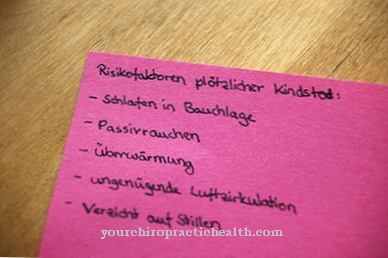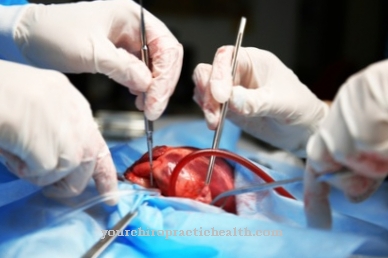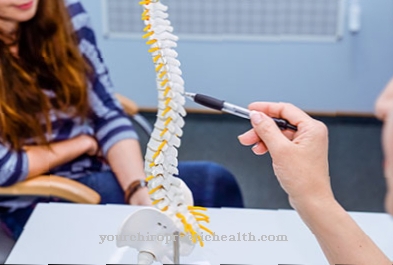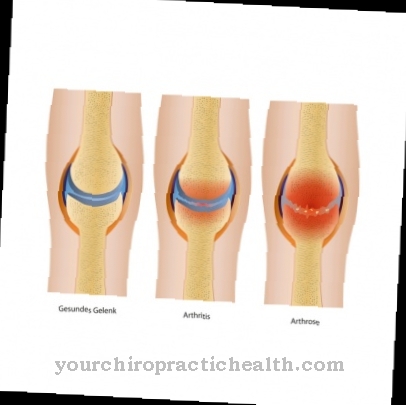The Periosteum inflammation or Periostitis affects the periosteum covering the bone. The disease, which is caused by various causes, is completely curable in most cases with proper treatment.
What is periosteum inflammation?

© geosap - stock.adobe.com
The Periosteum inflammation describes an inflammatory change in the periosteum of a person. In specialist medicine, the disease is therefore also called Periostitis are designated.
In most cases, periostitis is accompanied by thickening and water retention in the area of the affected periosteum. Periostitis often occurs in areas of a bone where tendons and / or muscles attach.
A distinction must be made, for example, between acute and chronic forms of periostitis; Periosteum inflammation is called chronic in medicine if the disease is long-term. Periostitis is usually considered chronic if the symptoms have been present for at least 3 months. Periostitis can be very painful and occurs comparatively often in athletes - periostitis is often localized here on the shin.
causes
A Periosteum inflammation can be mechanical as well as bacterial. The mechanical causes that can hide behind periostitis include prolonged overloading of the bone.
Especially in athletes, mechanical factors such as overtired muscles, wearing unsuitable footwear, misaligned feet or blows or kicks in contact sports can also promote periostitis.
If periostitis is bacterial, it usually develops as part of an infection with staphylococci (spherical bacteria) or streptococci (spherical to egg-shaped bacteria). Infection with various viruses can also lead to the development of periostitis. Corresponding pathogens enter the body, for example in the course of operations or open injuries.
If a person already has underlying infectious diseases, pathogens can enter the bloodstream from here and lead to periostitis elsewhere.
Symptoms, ailments & signs
Periostitis can lead to various health problems and, in individual cases, cause serious complications. Regardless of where the periostitis occurs, severe, usually throbbing pain develops as the disease progresses. These are particularly evident when moving or applying pressure to the affected area. It is characteristic of the pain that it occurs predominantly during physical activity and that it subsides quickly when the patient is resting.
The affected area may be red and overheated, and swelling may also occur. Movement restrictions are also possible. A purulent periosteum inflammation can cause accompanying symptoms such as malaise and fever. With this form, the pain can be very severe. Often a purulent discharge occurs in the area of the inflammation or a soft tissue fistula develops, which can ooze and cause itching.
The symptoms of periosteum inflammation usually appear very suddenly. The pain then leads to sleep disorders and depressive moods, which are accompanied by a further decrease in well-being. In individual cases, edema forms, which can lead to infections and skin changes. If the periostitis is treated early, the symptoms will soon subside. If left untreated, complications such as permanent movement disorders or chronic pain can arise.
Diagnosis & course
A patient consultation can give the attending physician initial clues as to the causes of a possible Periosteum inflammation give. In order to diagnose periostitis, corresponding areas of the body are usually examined for typical symptoms such as water retention or thickening.
Frequently, the attending physician scanning the part of the body affected by the symptoms also helps to confirm the diagnosis of periostitis. X-rays can be used to check whether periostitis is already chronic.
In contrast to acute periostitis, periostitis with a chronic course usually develops insidiously; the symptoms of chronic periostitis are often milder at first than in the context of an acute periosteum inflammation. With early and competent therapy, acute periostitis in particular can be completely cured in many cases.
Complications
Due to the periosteum inflammation, the patient has considerable limitations and complaints in everyday life. In most cases, the patients primarily experience relatively severe bone pain in the affected areas. This pain can occur in the form of resting pain or pressure pain.
Pain at rest can also lead to sleep disorders and thus to increased irritability of the patient. There is also usually severe swelling and redness and the patient's movement restrictions. The extremities are not infrequently warm and there is general tiredness and fatigue. The resilience of the person affected also decreases significantly due to the periosteum inflammation. Water retention can also occur in the affected areas.
Periosteum inflammation can usually be treated well if it is detected early. There are no particular complications. The treatment takes place with the help of therapies and medication and in most cases leads to a positive course of the disease. The life expectancy of the person affected is also not influenced by periosteum inflammation. In some cases, the periosteum inflammation can also lead to inflammation of the bone marrow.
When should you go to the doctor?
Periosteum inflammation is a disease or a symptom that does not require a doctor's visit immediately. This is due to the fact that the inflammation usually comes about as a result of excessive stress and in most cases heals spontaneously if the cause of the stress is eliminated. Before going to a doctor, it makes sense to first research the cause and eliminate it (for example, overuse during exercise or wearing unsuitable footwear). If the symptoms improve depending on whether the cause is omitted, a visit to the doctor is not necessary. Basically, this also applies if irritation is accepted again by allowing the trigger again.
Periosteum inflammation is also easily accessible to self-treatment. However, if the symptoms do not improve through resting and other measures such as cooling, the doctor should be consulted. This also applies to cases in which, even when the symptoms and their occurrence are closely observed, no connection with a triggering behavior can be determined. Here it makes sense to see the doctor to clarify whether there is another explanation for the painful reaction on the front edge of the shins. A visit to the doctor is also advisable for one-sided complaints that do not subside, as well as for severe symptoms.
Treatment & Therapy
The therapy one Periosteum inflammation is initially dependent on the individual cause of the disease. Periostitis, which is caused by overloading the affected bone, often shows up on the shin or forearm; The medical measures that are frequently used here include cooling and then resting the affected part of the body.
A corresponding immobilization is possible, for example, by applying a tape bandage (a bandage using adhesive plaster tape, which is especially used in sports medicine). Another component of therapy for periostitis caused by excessive stress is often the administration of so-called anti-inflammatory drugs - these are drugs with anti-inflammatory effects.
Periostitis caused by bacteria is often treated with antibiotic drugs. Occasionally, bacterial periostitis can be associated with bone marrow inflammation; this is especially the case with people who have a weakened immune system. Such a combined disease of periostitis and inflammation of the bone marrow is often treated with antibiotics with the help of infusions.
Outlook & forecast
In principle, periosteum inflammation is curable. It can be very tedious. The success of a therapy and the duration depend on the cause, extent and intensity of the disease. Age and the condition of the immune system also play a role as factors in healing. If the patients follow the therapy plans, there is a good chance that no permanent damage will remain and mobility will return.
If the cause is overwork, you can expect 1-2 weeks for noticeable relief in the case of mild manifestations. The absorption of the load on the corresponding part of the body should then only be increased slowly in order to achieve lasting improvement.
If the necessary rest breaks are not observed or if the cause of the one-sided stress is not eliminated when periosteum inflammation begins, this can lead to a protracted and serious illness. An established therapy plan should be followed consistently by the patient. Otherwise there is a risk that the inflammation will become chronic. In this case, surgery can help. After the operation, the affected body part must then be spared for several weeks to a month.
If a bacterial infection is the cause of the periosteum inflammation, medication can help quickly. If the pain in the affected body part subsides, the general physical condition of the patient must be assessed before the stress is resumed.
prevention
One caused by pathogens Periosteum inflammation can only be prevented to a limited extent; However, the risk of the disease can be reduced by strengthening the body's immune system. In sport, for example, avoiding excessive stress can prevent periostitis. Wearing the necessary protective clothing and appropriate footwear can also help prevent periostitis.
Aftercare
Periosteum inflammation is associated with a severe impairment of the immune system. Because of this, and because of the severe pain associated with the disease, it is extremely important to take care of yourself even after the therapy has been successfully completed. Aftercare initially consists of reducing your usual physical activities for a while.
This applies in particular to those sports or movements that have led to periosteum inflammation. If the disease was caused by bacteria, physical rest also applies as part of the aftercare. Athletes are strongly advised to keep the physical exertion at a moderate level for a few months after the periostitis has ended, so that the disease does not break out again.
Because if there is a lack of follow-up care and a too quick return to accustomed training habits, the periosteum may recur, although it seemed to have completely subsided after the therapy. The support of a health and fitness advisor is therefore an advantage after periosteum inflammation.
Follow-up care may also include patients having to give up certain sports altogether. In any case, it is necessary for those affected to have regular medical check-ups at least one to two years after the periosteum infection in order to have the condition of the periosteum assessed and to make statements about the inflammation values in the blood.
You can do that yourself
In the case of periosteum inflammation, extremely intense bone pain occurs, which significantly limits the patient's everyday life. Pain complaints occur both when performing movements and when the person concerned is resting. Taking painkillers brings relief here, so that overall well-being improves.
The extremities are poorly supplied with blood, as a result of which the patient freezes and often feels tired and bruised. A reduced resilience and a reduced ability to concentrate are not uncommon. Severe swelling and redness have a negative effect on well-being and water retention in the corresponding areas worsens the state of health. The affected person needs a lot of rest as well as medication and ointments in order to avoid a more severe course of the disease.
Depressive moods and anxiety states often further limit the quality of life. Psychological counseling and an exchange with other sick people provide support and have a beneficial effect on the state of mind. If the periosteum is treated early, complications rarely occur. However, the ointments and bandages can cause allergies. A preliminary clarification of the allergy risk can have a positive influence on the choice of ointment and medication. If the periosteum inflammation takes a purulent course, the patient becomes very unwell. The general condition is deteriorating and there is an immediate need for medical treatment.





.jpg)
.jpg)




















